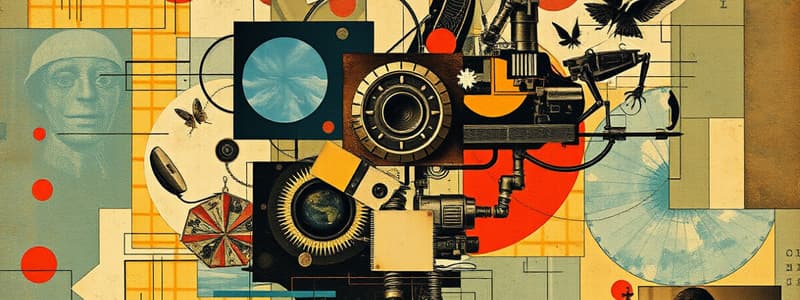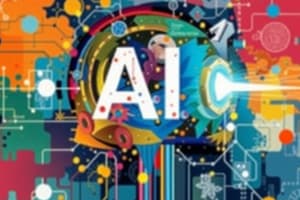Podcast
Questions and Answers
What was the main purpose of Alan Turing's publication "Computing Machinery and Intelligence"?
What was the main purpose of Alan Turing's publication "Computing Machinery and Intelligence"?
- To introduce the concept of Expert Systems
- To develop algorithms for mathematical problems
- To create the first artificial intelligence program
- To propose a way to evaluate a machine's intelligence (correct)
Which significant event is associated with the birth of the term "Artificial Intelligence"?
Which significant event is associated with the birth of the term "Artificial Intelligence"?
- The publication of Turing's paper in 1950
- The Dartmouth Conference in 1956 (correct)
- The development of the first chatbot, ELIZA
- The invention of high-level programming languages
What characterized the period referred to as the first AI winter from 1974 to 1980?
What characterized the period referred to as the first AI winter from 1974 to 1980?
- An increase in public interest in artificial intelligence
- A significant decrease in funding and research activity (correct)
- A surge in government funding for AI research
- Rapid advancements in AI technologies
In what year was the first intelligent humanoid robot, WABOT-1, built?
In what year was the first intelligent humanoid robot, WABOT-1, built?
What was one of the key features of the artificial intelligence program "Logic Theorist"?
What was one of the key features of the artificial intelligence program "Logic Theorist"?
Which programming languages were developed during the early years of AI's academic establishment?
Which programming languages were developed during the early years of AI's academic establishment?
The expert systems developed in 1980 were meant to emulate what?
The expert systems developed in 1980 were meant to emulate what?
What significant conference was held at Stanford University in 1980?
What significant conference was held at Stanford University in 1980?
Who were the pioneers of the first recognized work in AI in 1943?
Who were the pioneers of the first recognized work in AI in 1943?
What significant contribution did Donald Hebb make to the field of AI in 1949?
What significant contribution did Donald Hebb make to the field of AI in 1949?
What was the primary purpose of the Turing Test proposed by Alan Turing?
What was the primary purpose of the Turing Test proposed by Alan Turing?
What was a major milestone in AI development during the 1950s?
What was a major milestone in AI development during the 1950s?
Which area of AI is focused on creating systems that can mimic expert human decision-making?
Which area of AI is focused on creating systems that can mimic expert human decision-making?
Which of the following is NOT considered a subfield of AI?
Which of the following is NOT considered a subfield of AI?
In what year did Alan Turing pioneer machine learning?
In what year did Alan Turing pioneer machine learning?
What does the term 'Hebbian learning' refer to in the context of Artificial Intelligence?
What does the term 'Hebbian learning' refer to in the context of Artificial Intelligence?
What significant event marked the peak of AI capabilities during the second AI winter?
What significant event marked the peak of AI capabilities during the second AI winter?
Which milestone took place in 2011 that showcased significant advancements in AI's ability to understand human language?
Which milestone took place in 2011 that showcased significant advancements in AI's ability to understand human language?
What was the significance of the Turing Test in the context of AI development?
What was the significance of the Turing Test in the context of AI development?
In what year did AI begin to significantly integrate into personal spaces with the introduction of a particular household device?
In what year did AI begin to significantly integrate into personal spaces with the introduction of a particular household device?
Which development in AI in 2012 dramatically enhanced performance in image recognition tasks?
Which development in AI in 2012 dramatically enhanced performance in image recognition tasks?
What was one outcome of acquiring DeepMind by Google in 2014?
What was one outcome of acquiring DeepMind by Google in 2014?
What breakthrough did DeepMind achieve with AlphaFold in 2021?
What breakthrough did DeepMind achieve with AlphaFold in 2021?
Which advancements in AI technologies were highlighted as continuing trends in 2022?
Which advancements in AI technologies were highlighted as continuing trends in 2022?
Flashcards are hidden until you start studying
Study Notes
The Second AI Winter (1987-1993)
- Occurred due to high costs and unsatisfactory results leading to a withdrawal of funding from investors and governments.
- Expert systems, such as XCON, showcased cost-effectiveness despite the broader decline in AI investment.
Emergence of Intelligent Agents (1993-2011)
- 1997: IBM's Deep Blue defeats chess champion Gary Kasparov, marking a significant achievement in AI performance.
- 2002: Roomba introduces AI into homes as the first smart vacuum cleaner.
- 2006: Companies like Facebook, Twitter, and Netflix start employing AI technologies, signifying AI's entrance into the business sector.
Milestones of AI in the 2010s
- 2011: IBM's Watson wins Jeopardy!, illustrating advancements in natural language processing.
- 2012: AlexNet wins the ImageNet competition, significantly enhancing image recognition capabilities through deep learning.
- 2014: Google acquires DeepMind, a company specializing in deep learning and reinforcement learning techniques.
- 2016: DeepMind's AlphaGo beats Lee Sedol, the Go world champion, representing a major milestone in strategic AI.
- 2018: Release of OpenAI's GPT-2, showcasing advancements in natural language generation.
Developments in the 2020s
- 2020: OpenAI launches GPT-3, an advanced language model known for generating human-like text.
- 2021: DeepMind's AlphaFold demonstrates breakthrough accomplishments in predicting protein folding structures.
- 2022: Continued advancements across AI fields, including natural language processing and computer vision.
- 2023: Growth in AI ethics and fairness, with frameworks like AI Fairness 360 gaining importance.
- 2024: Expansion of AI applications across industries, particularly in healthcare, finance, and autonomous vehicles.
Overview of Artificial Intelligence
- AI represents a fast-evolving technology aimed at creating intelligent machines capable of human-like behavior and decision-making.
- Composed of two parts: "Artificial" meaning man-made, and "Intelligence" indicating cognitive abilities.
Historical Context of Artificial Intelligence
- AI's roots extend back to ancient myths of mechanical men in Greek and Egyptian cultures.
- Milestones in AI history highlight its development from an academic concept to practical applications.
Maturation of Artificial Intelligence (1943-1952)
- 1943: Warren McCulloch and Walter Pitts propose a model of artificial neurons, laying groundwork for neural networks.
- 1949: Donald Hebb introduces Hebbian learning, defining how neurons strengthen connections through activity.
- 1950: Alan Turing publishes "Computing Machinery and Intelligence," proposing the Turing test for machine intelligence.
Birth of Artificial Intelligence (1952-1956)
- 1955: Allen Newell and Herbert A. Simon develop the "Logic Theorist," the first AI program capable of proving mathematical theorems.
- 1956: John McCarthy coins the term "Artificial Intelligence" at the Dartmouth Conference, officially establishing the field.
The Golden Years of Early Enthusiasm (1956-1974)
- 1966: Development of algorithms for solving mathematical problems; Joseph Weizenbaum creates ELIZA, the first chatbot.
- 1972: WABOT-1, Japan’s first intelligent humanoid robot, is constructed.
The First AI Winter (1974-1980)
- This period saw diminished government funding and interest in AI research, leading to a decline in advancements and public enthusiasm for the field.
A Boom in AI (1980-1987)
- 1980: The revival of AI research with the rise of expert systems, designed to mimic human expert decision-making.
- 1980: The first national conference of the American Association of Artificial Intelligence takes place at Stanford University, indicating a resurgence of interest in the field.
Studying That Suits You
Use AI to generate personalized quizzes and flashcards to suit your learning preferences.




